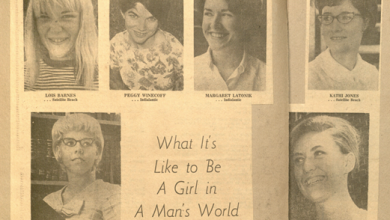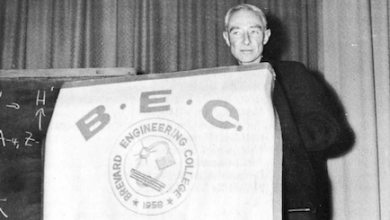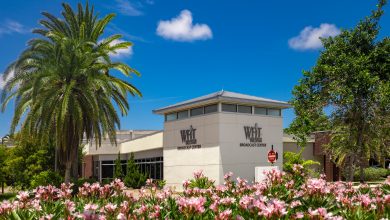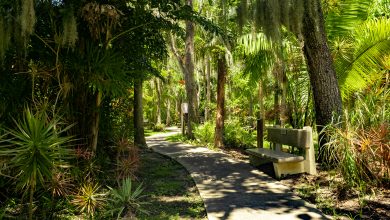The Secret History of Florida Tech’s Michelangelo
Dateline: 1978

The knock on the door was unexpected. It was barely seven o’clock in the morning. Three days earlier, Stanford (Stan) Zone, on June 9, 1978, had graduated from Mel High. His mother woke her sleeping son and told him that there was a man from Florida Tech there to give him a ride to work. Forty-two years later, Stan Zone is still getting up early and coming to Florida Tech. His story exemplifies the dedication and commitment to excellence that has made Florida Tech a special place.
In January 1972, Stan Zone’s mother moved her family to Melbourne from Miami. It was a hard time. A decade earlier, her husband, Stan’s stepfather, had been killed. That left her a single parent with seven sons. Three of her sons were already grown and on their own. Growing up, Stan and his brothers pitched in to help their mother. In the summer, they picked oranges and grapefruit to help their mother pay bills and buy clothes. At fourteen, Stan qualified for a summer youth work program aimed at helping young people. At the end of his junior year in high school, Stan learned that the youth program director had assigned him to work at Florida Tech as part of the paint crew.
On the Job
Gordon “Pop” Roberts led the two full-time painters. “Pop” Roberts was a three-hundred-pound behemoth with a well-deserved reputation for his salty, outspoken temperament. “Pop” Roberts knew a good worker when he saw one. At the end of the summer, he asked Stan if he would like to return to work for Florida Tech after he graduated from high school. Stan, who led Mel High’s championship wrestling team, told Roberts that he had not made up his mind on what he would do and promptly forgot the conversation.
“Pop” Roberts, however, had not. Three days after his graduation, Roberts sent Willi Buford to pick Stan up. Roberts told Stan that he and the other two full-time painters planned to retire in the next few years. The university needed to recruit a new generation of painters. Four years later, Roberts retired. Before leaving the university, Roberts was unsuccessful in convincing his superiors to name Stan Zone the painters’ supervisor. Upper-level administrators did not think that Stan had enough experience to manage both the painters and the budgeting process. Instead, Stan was named foreman and directed to report to Reuben Wooten, who headed the carpentry shop. Wooten was perplexed. Stan knew what needed to be done and did not need a carpenter’s advice. Thirty-two years would elapse before Stan Zone’s promotion to supervisor.

A good leader can make a difficult job manageable. This is what Stan Zone did. Periodically, Stan would host Sunday afternoon cookouts for his crew. Stan reshaped the painting department during his first decade at the university. The work was hard, but Stan built a camaraderie with his teammates. The painters won a host of trophies in departmental contests. They were a tight-knit body sharing the good and bad together. In 1986, when “Pop” Roberts died, Florida Tech painters served as pallbearers at his funeral.
Scandal in High Places
Florida Tech faced formidable challenges in the 1980s and 1990s. The problems started with the acquisition of a moribund Hawthorne College in Antrim, New Hampshire. The purchase of Hawthorne College precipitated a crisis that would lead to the closing of the Jensen Beach campus and contribute to Jerry Keuper’s reluctant decision to retire in 1986. Matters came to a head in 1987 when it was revealed that Jim Lyons, the full-time, paid chairman of Florida Tech’s Board of Trustees, had been interviewed four years earlier by the Federal Bureau of Investigation as part of a probe into diploma mills.
The FBI investigation exposed a cascade of falsehoods about Lyons’ academic and military background. During the interview, Lyons acknowledged that he had purchased a bachelor’s and master’s degree in 1981 from the National College of Arts and Sciences. Later, Lyons used the two bogus diplomas to procure a doctorate in management from an unaccredited for-profit university located in St. Louis. Lyons’ claim to have been a test pilot at Edwards Air Force Base proved equally untrue (Cory Jo Lancaster of The Sentinel, 1987b). On July 2, the New York Times reported that Florida Tech’s Board of Trustees had launched its investigation. The scandal intensified when it was discovered that both Jerry Keuper and John Miller had learned of the FBI investigation.

Two weeks after the story broke, Melbourne attorney Bill Potter, who stepped in as acting chair of the Board of Trustees, announced Lyons’ retirement (Cory Jo Lancaster of The Sentinel, 1987a). A few weeks later, Lynn Weaver, Florida Tech’s third president, arrived on campus. Years later, President Weaver acknowledged that what he discovered shocked him. It would take nearly a decade to put things in order.
A New President and a Master Painter
Lynn Weaver was a staunch believer that first impressions matter. In August 1987, he did not like what he saw. The campus was roiling in the wake of the Lyons controversy. An inspection tour revealed leaking roofs, broken air conditioning systems, and a neglected group of classrooms called the Annex. Refurbishing the university’s infrastructure was something that could not be done overnight. A coat of paint, however, would be a start. Stan Zone and his team went to work, making the university shine.

Those who served during those years remember the challenges. For Stan Zone, it meant summers in which he and his crew worked ten-day, ten-hour shifts. Stan led by example. His can-do attitude was infectious. There were comic moments. On one occasion, Jonathan Payne, who had recently joined Stan’s team, was painting the Southgate Apartments. Payne was near the top of his ladder when he lost his balance and toppled to the ground. A few minutes later, a sheepish but uninjured Payne reported the accident to his boss covered from head to toe with white oil-based paint.
The Most Valuable Panthers
For Stan Zone and his team, the work never stops. In 2019, Stan and his seven colleagues (Raphael Dowdie, Alonzo Neal, Jonathan Payne, Edward Hink, Wayne Bailey, Cindy Goodman, and Travaris Mack) used 38,000 gallons in painting and retouching 274 dorm rooms, 262 apartments while touching up countless offices and workspaces. It is a big job, and they do it well. Stan Zone was a principled man. His colleagues knew Stan Zone could be counted on. Years later, the faculty and staff recognized his service to the university by naming him a Florida Tech MVP (Most Valuable Panther).

Seventy-five men and women are responsible for maintaining the 2,000,000 square feet of classrooms, laboratories, housing, dining, office, athletic facilities, and grounds that make up the 177 acres constituting the university’s Melbourne campus. Their service to Florida Tech is monumental. Each of the crafts and trades deserves recognition. The hours are long and the pay meager. Nevertheless, each day the plumbers, the electricians, the grounds’ keepers, carpenters, and painters in Facilities Operations set to work, making Florida Tech a special place. These men and women are special. They are Florida Tech standouts.* Stan Zone is Florida Tech’s, Michelangelo.
*In terms of years of service, these individuals give meaning to the expression “Panther for Life.”Joseph Straniti (Lead Electrician) 34 years, Jeffrey Sherman (Automated Building System Engineer) 32 years, Leonard Harrison (Lead, HVACI III) 31 years, Frederick Bristol (Welder II) 31 years, and Cheryl LeBlanc (Director Business Operations) 28 years.
Note: In May 1987, six weeks before news of the FBI investigation broke, Jim Lyons summoned Father Doug Bailey and the author to his office in the Shepherd Building. The University archive had a collection of papers donated by Professor Walter Douglas consisting of the responses from famous Americans who had been asked to give their advice on living a virtuous life. Lyons charged Father Bailey and the author with the task of drawing up a set of “Rules for Good Living,” which they would present in a university colloquium to the faculty, staff, and students in the autumn. The university colloquium was canceled.
Cory Jo Lancaster of The Sentinel, S. (1987a, 07/07/1987 Jul 07). FIT’S LYONS WILL RETIRE OVER QUESTIONS OF CREDENTIALS: [2 STAR EDITION]. Orlando Sentinel, p. D1. Retrieved from https://search.proquest.com/docview/277108201?accountid=58632
Cory Jo Lancaster of The Sentinel, S. (1987b, 07/03/1987 Jul 03). FIT LOOKING HARD INTO LYONS’ PAST: [3 STAR EDITION]. Orlando Sentinel, p. D1. Retrieved fromhttps://search.proquest.com/docview/277114158?accountid=58632






